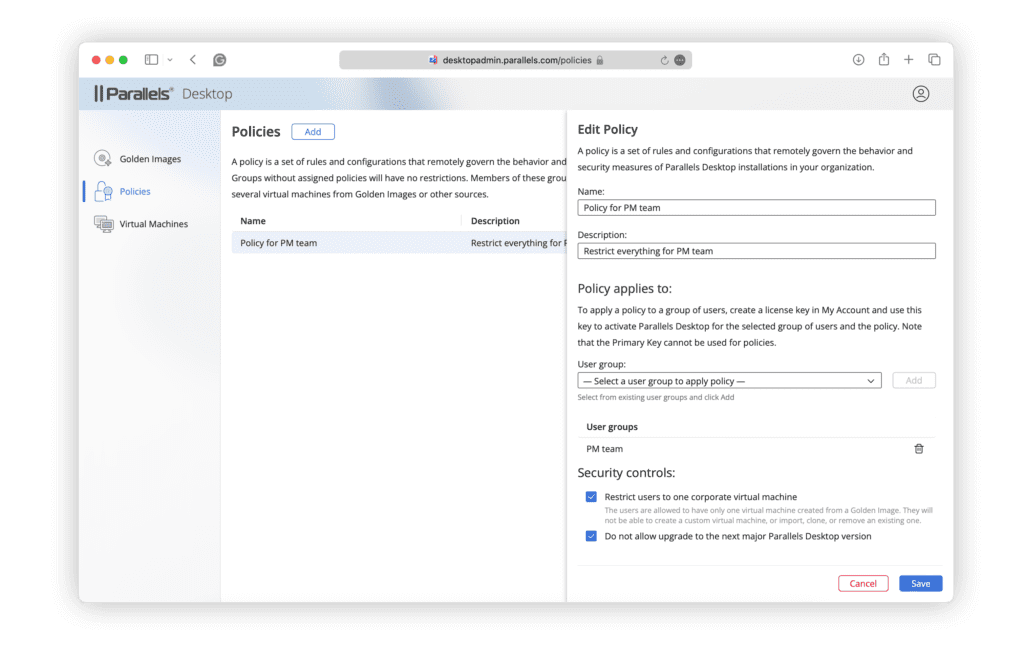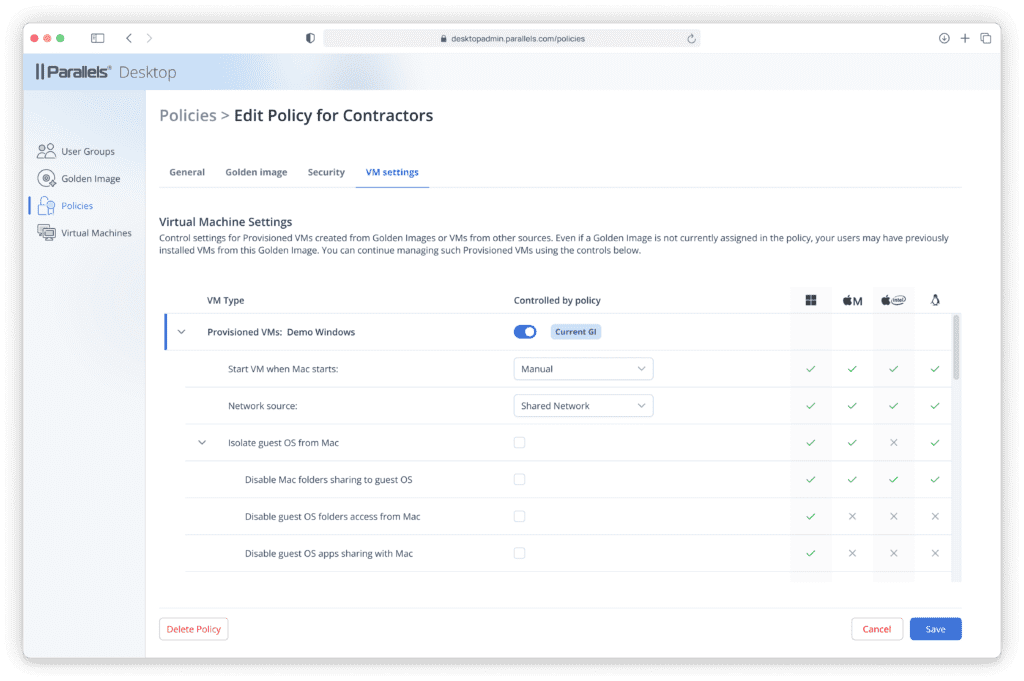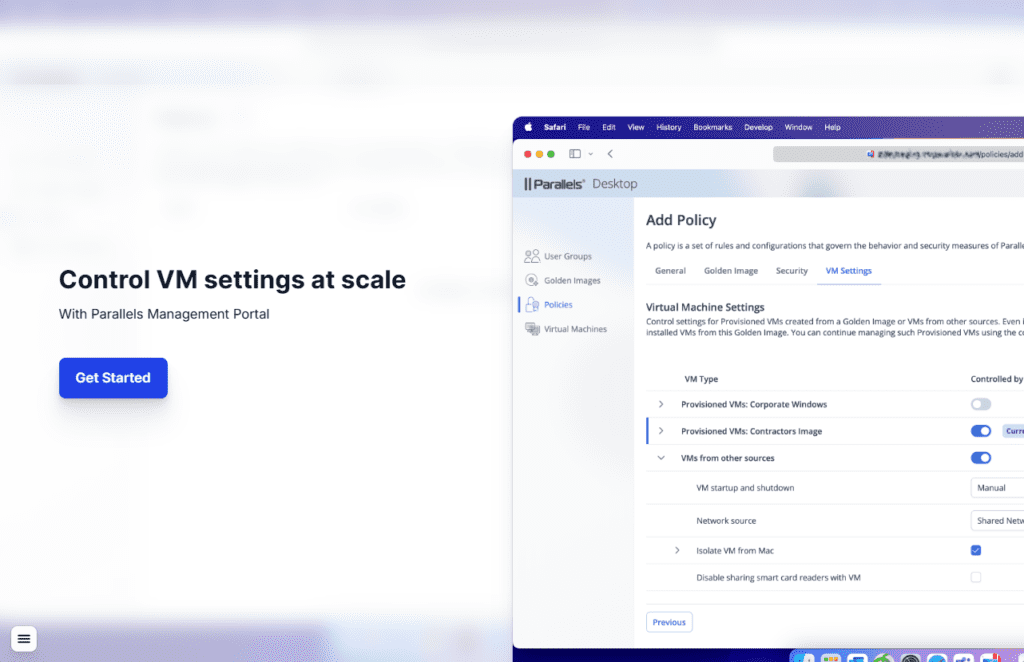
Gain better oversight for Parallels Desktop Enterprise with granular settings control through VM policies
Give developers freedom with guardrails, protect contractors and internal data, and keep legacy apps safe—all from one place.
Modern Mac fleets increasingly run Windows and Linux side by side with macOS. That flexibility is great for productivity—but only if IT can set some ground rules.
That’s why I’m excited to share that Parallels Desktop now lets administrators centrally define and enforce what virtual machines (VMs) can access on Mac devices using granular policy controls in the Enterprise Management Portal.
Curious what’s different for enterprise-level VM control? Try Parallels Desktop Enterprise Edition today.
What Parallels Desktop policy management means for IT teams
With the new policy‑based control in Parallels Desktop for shared folders, clipboard access, application sharing, network mode, and USB connectivity, IT teams can now support flexibility without sacrificing control.

This means administrators can:
- Let users create VMs while keeping critical settings under admin control
- Ensure every VM complies with security requirements—even after deployment
- Apply different rules to provisioned images and user‑created VMs
- Manage Windows, Linux, and macOS VMs across Apple silicon and Intel hosts without extra servers or cloud build‑outs
Whether users download a golden image (GI) provisioned by IT or create a VM from scratch, Parallels Desktop keeps settings compliant, with all configurations defined in the Enterprise Management Portal.
Features you’ll find in Parallels Desktop VM policy management
Improving IT control over VMs is all about the details.
The configuration options and flexible settings in Parallels Desktop make VMs powerful for users, but they also introduce risks and variability.
The new centralized policy management capabilities in Parallels Desktop Enterprise Edition bring enhancements and new features to handle even the smallest details. This way, IT teams can define, enforce, and monitor these configurations remotely, ensuring consistent and secure setups and preventing big impacts on corporate compliance.
- Enforce virtual network mode: Enforce limiting VMs to a specific network mode—like Shared or Bridged—and prevent users from switching adapters.
- Block VM access to external USB devices: Prevent passthrough from USB drives, printers, smart card readers, and other external devices into the VM.
- Control clipboard sharing: Control or block copy-paste operations to avoid transferring sensitive data. Options include full sync, one-way sync, or complete isolation.
- Prevent access to Mac folders: Turn off access to macOS folders from within the VM to protect sensitive files and reduce data leakage between host and guest systems.
- Restrict configuration changes: Prevent end users from modifying critical VM settings outside of policy scope.
- Enforce OS isolation: Run Windows fully isolated from macOS, preventing any sharing of files, devices, and the clipboard for maximum security and privacy.
- Assign policies dynamically: Assign policies conditionally based on the VM source, either corporate-provisioned or user-created, and the end user’s group.
- No extra infrastructure required: Unlike many traditional virtualization management tools, Parallels Desktop doesn’t require expensive cloud infrastructure or on-prem servers to manage your VMs. Everything is handled on the device using centralized controls. This makes it ideal for fast-moving teams that need secure, reliable virtualization on Mac devices.
See Parallels Desktop Enterprise Edition in action
Want to see how it all comes together?
Walk through the process with our guide to see how you can find and activate new settings, create your own custom policies, apply golden images, and manage settings on deployed VMs.
Parallels Desktop Enterprise Edition in the real world: Assigning VM policies with granular control
What do these changes look like in a real-world scenario?
Let’s explore some common use cases and ways organizations can apply VM policies and the new controls available in Parallels Desktop Enterprise Edition.
Developers: Cross-platform freedom that’s compliant by default
Engineering teams need to run Windows and Linux alongside macOS for browser, SDK, and CI checks. They move fast, switch toolchains, and sometimes take risks because deadlines are real.
Organizations, though, need to be confident that source code and credentials are safe and won’t leak out through shared folders, USB access, or accidental copy-pastes.
How policies help: Your organization can lock each VM to an approved network mode (either Shared or Bridged), turn shared folders off by default or allow them with clear repo/DLP rules, limit clipboard direction to host to guest only, and block USB permissions entirely.
This way, devs can still access the OSs they need, and the guardrails remove easy exfiltration paths and configuration drift.
Contractors and freelancers: Protected by default
Contractor teams need access to corporate systems to do their jobs, but often, they’re bringing their own devices to your secure network.
Organizations need to be able to provide secure workspaces for safe access—without building out VDI or shipping corporate hardware.
How policies help: Your organization can deliver GIs to contractors with strict boundaries, including no shared folders, no clipboard, no USB, and a fixed network mode. You can also tie VM encryption to your Parallels Desktop license, so the VM’s data can’t be accessed without your license.

This way, contractors get a clear boundary between the work they do for you and everything else on their device. And your organization maintains clean, isolated, and encrypted workspaces that keep auditors and timelines happy and all data safe within your infrastructure.
Non-technical workers: Simple access to legacy Windows apps
Your finance team might need add-ons for Excel. Your lab might need a vendor controller. Or maybe your operations team uses an old Windows app that never released on macOS. Everything else lives in macOS just fine, and they don’t want to learn about using VMs.
How policies help: Your organization can keep VMs simple and focused. You can deploy the app your team needs in Single-App mode to hide the rest of Windows, lock the network mode, set clipboards to bidirectional, block USB permissions, and allow app sharing so it all feels inherent to macOS.
This way, your workers get uninhibited access to the legacy app they need without feeling overwhelmed by the technical side of it.
Discover how enhanced VM policy control can improve Mac fleet management and more
Ready to explore what’s new in Parallels Desktop Enterprise Edition? Test out the latest features for VM policy control with a free trial today.

